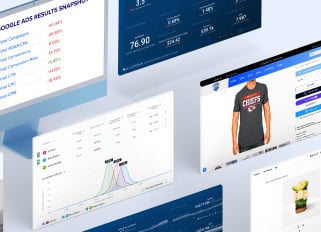
10 Effortless Updates Ecommerce Sellers Can Make to Boost Google Ad Sales
Google Ads campaigns can generate leads in the $5.7 trillion online shopping industry, whether you have a few ads or more. However, reaching profitable online sales requires more than creating Google Ads accounts and launching shopping campaigns. A few updates to your marketing strategy can make the difference and make your ad spend budget more worthwhile.
Updating your product images, pricing, keyword matches, negative keywords, landing pages, etc., is a stress-free approach to positioning for more sales. You can also go beyond these, including Google remarketing ads and a Facebook ad campaign. The processes or steps you can take are endless, but we’ll keep them to a few essential ones.
This article is for you, whether you’ve run Google Ad shopping campaigns before or this will be your first time with online ads. So, without much fanfare, let’s dive into a few updates you can tweak now to revamp your Google Ads campaign ads.
Do These Ten Things to Boost Google Ads Sales for Your E-commerce Business
These tweaks are straightforward, but they require a bit of expertise to implement them. Contact an e-commerce marketing agency that is into paid advertising if you are not an expert.
You can suggest these updates to your team and watch your eCommerce Google ads reach new heights. In addition, you should monitor your Google Ads budget because some tweaks may require financing.
With that in mind, here are ten things you can do to climb the ladder of over 12 million eCommerce sellers:
1. Update Your Product Image
Let’s begin with a simple search ad tweak. This one requires no financing, as it is as simple as changing the display image on your Facebook or Instagram profile.
Pictures increase the visual appeal of eCommerce Google ads. They also boost brand awareness and reach when colors and logos are used.
Video campaign types are the best, with more engagement than images and text ads. However, they are best reserved for social media. We’ll talk more about it when creating Facebook retargeting campaigns for an online store.
Search for your keywords on Google Shopping and see how other products appear. That will give you an insight into how other eCommerce sellers structure their Google Shopping campaigns visually. Then, you can quickly figure out how your product images can stand out in the search results during display campaigns.
Once figured out, update the image for your Google Ad campaign or test Google Ads to see which performs better.
2. Update the Price
This tweak must be done with utmost care. Of course, you don’t want to end up with a loss even though you have more sales.
Lowering prices on your eCommerce Google Ads campaigns can increase clicks. Also, more buyers will be willing to cash in on the lower prices for the same goods.
Again, you should begin by studying your competitors’ eCommerce Google Ads campaigns for the same product. Review their prices and see how much you can take off without eliminating profits. Ensure you factor in your expenses and profit margin for each sale before taking off a few dollars.
Updating prices is an effective marketing strategy that is simple to implement. Besides Google search results, it is used on eCommerce platforms like Amazon ads, Walmart, eBay, etc.
3. Improve on Negative Keywords
This tweak is vital for running video, image, or text ads on a search network. It is easier to focus on positive keywords for eCommerce Google Ads campaigns. However, you should also include words and phrases you want to eliminate searchers irrelevant to your products.
Here are a few benefits to updating negative keywords on your eCommerce Google Ads campaigns:
-
Keep return on investment on track by eliminating search ad spending on irrelevant keywords
-
Ensure that only relevant Google search ads are shown to searchers
-
Increase the Google search traffic, a step towards getting a reasonable conversion rate
-
Negative keywords help control ad spending for your Google shopping campaigns. They streamline the search results, allowing only relevant Google shopping ads to appear. Also, you can update them in your campaign ad groups.
-
The following approaches can help you find negative keywords for your Google shopping ads:
-
Review the autocomplete feature of the Google search network. That will show you your Google shopping campaigns' positive and negative keywords.
-
Review the search results for your intended keywords. You’ll identify negative keywords on the search network. Remove a keyword if it returns search results different from your product.
-
Use research tools. Today, you can use AI software to research negative keywords faster.

4. Add Longtail Keywords
Longtail keywords are less competitive, giving you more prominence in search results. Hence, you can get more traffic if you create ads with them. They play crucial roles in any search ad marketing strategy.
The following are ways you can find longtail keywords for your Google shopping ads:
-
Use public forums to find questions people ask regarding that product. You’ll discover longtail phrases you can use for wider Google campaign audiences.
-
Use the autocomplete feature of the search network. Alternatively, you can also use research tools to find them.
-
Review the Google Analytics for your online store to find longtail keywords people use to find it. Use this approach for the products you want to run Google search ads for.
5. Update Your Retargeting Lists for Smart Google Shopping Campaigns
You don’t need to create ads exclusively to target search ad clickers. Google smart shopping campaigns can work off your retargeting lists to reach them. It combines standard shopping campaigns with display campaigns to retarget prospective buyers.
Smart shopping campaigns have the following benefits:
-
Combine existing product feed and assets into Google retargeting ads for many networks.
-
You can quickly view the test results on Google Analytics
-
The bid strategy is automotive, meaning you will get the maximum conversion value for your ad spend.
-
There is easy integration for third parties. You can seamlessly use their ad extensions for Google Ads campaigns.
-
Google remarketing ads can help you increase sales by reaching buyers who were previously interested in your products.
.jpg?width=600&height=400&name=online-shopping-2023-11-27-05-04-21-utc%20(2).jpg)
6. Update Your Bid Strategy for Your Online Store and Competitors
If you haven’t already, it’s time to bid on the name of your online store. This bid strategy is essential to increasing brand awareness and reach. Shoppers that use keywords in the name of your online store will see you.
Avoiding this update means competitor search results will take precedence over yours. The same thing will also happen in display campaigns.
Besides your eCommerce site, you can also bid on other online stores. Their shoppers might find your offer more enticing and come to your platform. Nonetheless, you must be aware of the following:
-
Don’t use trademarked names in your landing page URL
-
Pick competitor search pages that have similar audiences to you
-
Avoid this marketing strategy if you are new to the business. More established online stores will push your ranking down the search pages.
7. Turn on Google Ad Extensions
The user experience and visual appeal of Google shopping ads contribute to their success. Text ads are less effective at increasing clicks than video ads.
Google Ad Extensions add more color to the user experience. A few you can activate on your Google Ads account include the following:
-
Sitelink
-
Callout
-
Reviews
-
Structured snippets
-
They can help you highlight promotions, brand information, important product details, etc. Use as many ad extensions as possible for your Google Ads account. Nonetheless, ensure they are relevant to the shopping ads.
8. Update Locations in Your Shopping Ads
One powerful feature of your Google Ads account you should use is location. Adding locations can give you an upper hand in local campaigns.
Before running local campaigns, you don’t need to own a brick-and-mortar store in these areas. Online stores have used fulfillment centers to reach the end user. Also, buyers will be more likely to buy if they can get the products faster at their locations.
Go to your Google Ads account and select “ad assets” to add new location assets. Then, select which shopping ads or ad groups to add to the locations.
9. Retarget on Facebook
Update your Facebook ad campaign to retarget people from your Google shopping ads. Social media can be effective in drawing people to the Google search network.
Make the Facebook ad headlines catchy. Notwithstanding, this tweak requires an omnichannel marketing strategy.
It will raise your Google ad budget. Your brand awareness and reach will increase because you are reaching more people.
10. Update Your Keyword Match Types
This tweak will not affect your ad spend. You can continue with your budget while boosting the chances of getting clicks on your shopping ads. However, you’ll spend more to create new campaigns with matching keywords.
You can do a competitor search to find more words and phrases for your shopping campaigns. Use different keywords for the campaigns or split them into ad groups. Then, analyze which keyword matches perform better.
The Segments Will Get Smaller - Final Thoughts
Your budget needs to get your shopping campaigns the best results. Most online stores begin with broad targeting to optimize the budget. However, you will opt for smaller segments and targeted marketing to reach people who want your products.
The approach might make running the shopping campaigns complicated. However, it will boost your ad sales if adequately managed.
Interested in e-commerce google ads services? Contact our team at Bluetuskr, an e-commerce marketing agency.
Connect With Us
Recent Post

.png)







Tell us what you think!